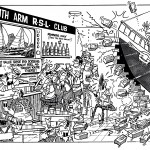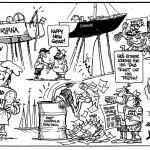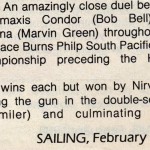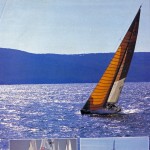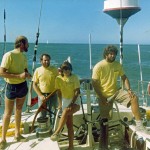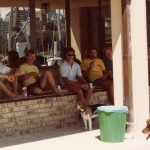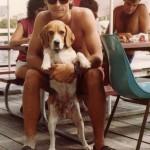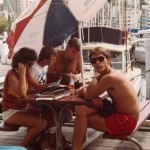| Condor | |
|---|---|
 | |
| Country | Bermuda |
| Sail Number | KB80 |
| LOA | 24.68m, 81f |
| Year Build | 1981 (age 43) |
| Owner (s) | Bob Bell |
| Designer (s) | Ron Holland |
| Builder(s) | Penryn Ship Yard |
| Former Crew | George Canfield Glen Miles Julie Hodder |
Condor
Condor, a maxi sailing yacht designed by Ron Holland was built in 1981 at Penryn Ship Yard, UK.
From Wikipedia https://en.wikipedia.org/wiki/Condor_(yacht)
Condor was revolutionary both for having the largest (tallest) single spar mast in the world (at the time of her launch) and for being the largest of all the IOR Maxi fleet at that time. (Ongoing IOR rule changes allowed each new yacht to be slightly bigger than ones built under previous versions of the rating rules).
She was built from Kevlar and composite structures, with an aluminium space frame inside. She was the second yacht of this type to be built where the hull itself could support the enormous loads generated by the huge mast and rig.
1983 Hobart | Sailing Magazine Feb 1984An amazingly close duel between the Maxis Condor (Bob Bell) and Nirvana (Marvin Green) throughout the 4 race Burns Philip South Pacific Maxi championship preceding the Hobart (2 wins each, but won by Nirvana's getting the gun in the double scoring 180 miler) and culminating in the grounding and collision six miles short of the finish line in the 630nm Sydney to Hobart Race. Condor was left parked on White Rock for 5 minutes while Nirvana slid on to get the gun by 2m 16s. The race continued in the protest room the next day. Ted Turner, who had been at the wheel (and whirled to the deck at the impact) handled Condor's protests without witnesses but with the help of a video played over and over. The jury disqualified Nirvana for failing to give Condor sufficient shore room. Modern Boating ArticleCondor and Nirvana Protest (Modern Boating Article) By 10.30 am on December 30, 54 yachts had berthed, Challenge was looking unbeatable and the protest hearing between Nirvana and Condor was due to start in the boardrooms of the Wrest Point Casino. Condor was represented by the outspoken Ted Turner, who'd been at the helm when the incident occurred, relying on his own evidence and the introduction of video film. Nirvana's case was presented by navigator Peter Bowker, who called in crewmen Geoff Prior and Steve Colgate (who'd been at the helm at the time) as witnesses. While the protest committee of Tasmanian officials Frank lkin, Olaf Hedburg, David Burton and David Peacock, and chairman Dr john Park (president of the Hong Kong Yachting Association) deliberated for over an hour to reach their decision, Ted Turner provided ample diversion for the yachtsmen, news crews and journalists waiting in the corridor outside. The cable news network owner held court on subjects ranging from disarmament ("lf l were President . . ."), to his friendship and admiration for Fidel Castro, to the politics of television (with some good-natured dissension between himself and Marvin Green, another television magnate responsible for Sesame Street and That's Incredible, among other programs). Turner even offered $100,000 off the cuff for any verifiable sighting of a Tasmanian 'tiger'. Then he and Bowker were called back into the protest room and emerged with a decision in Condor's favour. A dignified Green conceded that the protest committee's task had been a hard one and though he wasn't happy with the decision, he accepted it. Bell and Turner were also low-key, feeling that their rights had been vindicated but "sorry to see it end like this." Facts found by the committee were as follows: "Nirvana on starboard tack was being overtaken by Condor also on starboard tack. Condor was sailing faster than Nirvana and overtook her to windward and between her and the shore. At the time the overlap was established there was sufficient room for Condor to establish it in safety. The overlap was established at least five lengths prior to the position of the grounding. Both yachts had steerageway, but were moving slowly with Condor moving faster than Nirvana. Condor hailed for water while holding a course to clear the White Rock. Nirvana was sailing higher than Condor and holding a course closing the shore. Condor hailed again for room and Nirvana commenced to pull away. Condor struck the bottom and stopped. Condor did not have sufficient room to clear the shore and her stopping caused a minor contact between the yachts after the grounding. Rules applicable are 42.1 la); 42.3 (a) and 42.3 (f)". The decision: "Nirvana is disqualified for failing to give Condor sufficient room. Condor's request for time is rejected as it does not meet the requirements of Rule 69 (a), (b) or (c)." Reporters turned to race records to find that only one 'first home' yacht had been disqualified from previous Sydney-Hobarts. Wild Wave was scrubbed from the 1953 race for a start line infringement. Back at the dock, the goodwill between crews of the two maxis was testimony to how close the racing between them had been and how little either side had wanted it to "end like that". |






